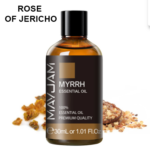The real Rose of Jericho
Myrrh Oil
In Christian Scriptures, Myrrh was one of the gifts of the Magi to the infant Jesus according to Matthew, and is cited in Mark as an intoxicant that was offered to Jesus during the crucifixion:
“Then, opening their treasures, they offered him gifts, gold and frankincense and myrrh.”
-Matthew 2:11b, RSV ”
“And they brought him to the place called Gol’gotha (which means the place of a skull). And they offered him wine mingled with myrrh; but he did not take it.”
– Mark 15:22,23 RSV ”
Because of both of these contexts, myrrh is a common ingredient in incense offered during Christian liturgical celebrations (see Thurible). In Roman Catholic liturgical tradition, pellets of myrrh are traditionally placed in the Paschal candle during the Easter Vigil.
In Eastern Christianity, the use of incense is much more frequent than in the West. In some traditions, special emphasis is placed on the offering of incense at Vespers and Matins, because of the Old Testament regulation regarding the evening and morning offering of incense.
Because myrrh was the primary ingredient in the anointing oil God commanded Moses to make (Exodus 30:23-33), it is used in the preparation of chrism which is used by many churches, both Eastern and Western






